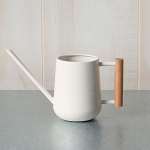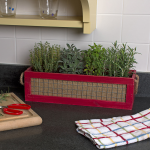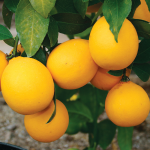Product Details
The juice of Key Lime (Citrus aurantiifolia) gives a sparkling tang to pies as well as Mediterranean, Mexican, and Asian recipes (it will also spruce up any drink from ice-cold water to something stiffer). Although many people associate the Key Lime with Key West, Florida, it is native to Malaysia and is now grown all over the world in warm climates. The tree is fairly vigorous, somewhat bushy in habit, and has sharp thorns on its branches. The fruit is small and round, with a very thin, smooth rind that turns from dark green to greenish yellow or yellow when ripe. The flesh is also light greenish yellow and very juicy. Key Lime pie that looks green, not yellow, has been artificially colored. Mature plants produce fruit in August and September.
Gardeners and cooks in all regions of the country can grow Citrus trees with our specialty plants. Gardeners in Zone 10 can expect them to reach 6-10' tall when planted in the ground. Elsewhere in the country, Citrus should be grown in containers and will stay smaller, eventually reaching 4-5'. In cold climates, containers may be moved outside during summer to a sunny spot protected from the wind, then brought back indoors before frost.
- Shipped in handcrafted clay Cottage pot that measures approximately 10" wide x 8½" tall with matching saucer
- Includes a slow-release Citrus fertilizer (18-5-10) to sprinkle at the base of your plant, and a foliar micronutrient concentrate for spraying on the leaves (spray bottle not included)
Shipping
WEATHER PERMITTING - Working with Mother Nature
In our business, we work closely with Mother Nature. In the colder months when we stipulate that an item is shipped “weather permitting”, that means temperatures outside our shipping facility in northwestern Connecticut and along the shipping route must be warm enough for tender plants to survive in unheated delivery trucks. Our practice of waiting for windows of milder weather may result in the occasional delay, but our customers tend to appreciate the care we take to make certain their plants arrive in the very best possible condition. Questions? Don’t hesitate to call our customer service staff at 1-800-411-6159.HOW PLANTS ARE SHIPPED
The size of the plants we ship has been selected to reduce the shock of transplanting. For some, this means a large, bareroot crown. Others cannot travel bareroot or transplant best if grown in containers. We ship these perennials and annuals in 1 pint pots, except as noted. We must point out that many perennials will not bloom the first year after planting, but will the following year, amply rewarding your patience. We ship bulbs as dormant, bare bulbs, sometimes with some wood shavings or moss. Shrubs, Roses, vines, and other woody plants may be shipped bareroot or in pots. The size of the pot is noted in the quick facts for each item.
WHEN WE SHIP
We ship our bulbs and plants at the right time for planting in your area, except as noted, with orders dispatched on a first-come, first-served basis by climate zone. We also ship a wide range of containers and planters, tools, supplies, fertilizers, garden wear, garden decor items, as well as indoor decorations like wreaths and dried bouquets when available. Estimated dates for shipping are indicated in the green Shipping Details box for each item. Please supply a street address for delivery. Kindly contact us with two weeks notice, if you'll be away at the expected time of delivery.
OUR GUARANTEE
We guarantee to ship plants that are in prime condition for growing. If your order is damaged or fails to meet your expectations, we will cheerfully replace or refund it. Please contact our Customer Service Department at 1-800-503-9624 or email us at [email protected]. Please include your order number or customer number when contacting us.
Reviews
Average Customer Rating:
 (2 Reviews)
Write a Review
(2 Reviews)
Write a Review
Sort by:
Sweet, Tart Perfection! 
Maya from New York City
As soon as I received this plant from White Flower Farm it began producing fruit. It continues to thrive and blossom these beautiful little white flowers and fruit two years later. I can’t wait till they get more in stock.
Paid for key lime, sent Mexican lime 
A viewer from Los Angeles, CA
I have accessed your order and the information indicates I responded to your concerns via email on 5/27/19. I will send the information again today. The Key Lime and the Mexican Lime are one in the same.
Sincerely,
Cathy
1 of 4 people found this review helpful. Do you? yes no Certified buyer
Growing guide
The leaves of Citrus hystrix are best used fresh, but they can also be stored in the freezer in resealable plastic bags. Use the leaves in sauces, stews, and marinades, adding whole leaves early in the process and removing them before serving the dish. The rind of the Lime Leaf fruit, rather than the flesh or juice, is also used in cooking. It has the same flavor found in the leaves. Simply zest the rind, and add it to dishes. For specific recipes, look in Indonesian, Malaysian, Vietnamese, and Thai cookbooks. Another common name for Lime Leaf is Kaffir Lime.
When you receive your plant, do not be alarmed if it begins to drop flowers, fruit, and/or foliage, as this is the plant’s reaction to being shipped. Citrus plants need at least 4–6 weeks to acclimate to a new location and this acclimation can take longer if the plant is receiving less than 6 hours of direct sun per day. During this time, DO NOT fertilize the plant, as this will cause further stress. Once the plant is acclimated—which means the plant is able to produce and maintain new growth—you can begin fertilizing according to our recommendations mentioned below.
In most of the United States, these plants must be grown indoors, at least during the winter. Fortunately, their rootstock will keep them a manageable size (to no more than 4-5ft in a container), so they can summer on the patio and spend the winter in a greenhouse, an enclosed porch, or near a sunny, south-facing window. Move the plant outdoors in late spring if you'd like, but wait until the weather is warm and settled.
Gardeners in Zone 10 and warmer can grow Lime Leaf outdoors. Set the pot outdoors in a sheltered, lightly shaded spot, increasing the exposure to sun and wind each day. Check the moisture of the potting mix and water thoroughly if it's dry. At the end of one week (give or take a day or two), your plant will be ready to go in the ground. Choose a spot for your plant that receives full sun (at least 6 hours of direct sun each day) and is protected from drying winds. Planted in the ground, our Citrus will grow approximately 8ft tall.
Whether in the ground or in a container, Citrus need steady moisture. Water when the soil is dry to an inch deep. Don't let the tree dry out. If it does dry out, there's a good chance it will drop leaves, fruit, or both. If excessive drying is due to wind outside, move the tree to a more sheltered location. Mulch with bark chips or gravel around the base of the tree (keep it back a few inches from the trunk) to conserve moisture.
Citrus are also heavy feeders: After your plant has acclimated fully to its new home, feed lightly all year long with a fertilizer that has an N-P-K (nitrogen-phosphorus-potassium) ratio of 3-1-1 plus micronutrients, including zinc, iron, and manganese. Miracid (30-10-10), which is widely available, works well (refer to the manufacturer's instructions for concentration). Leaf yellowing generally indicates insufficient fertilizer or poor drainage.
Prune Citrus at any time of the year except winter. Pinch growing tips and cut back leggy branches to help a spindly tree fill out. Suckers (shoots growing from below the graft or emerging from the soil) should be cut back as soon as they're noticed.






